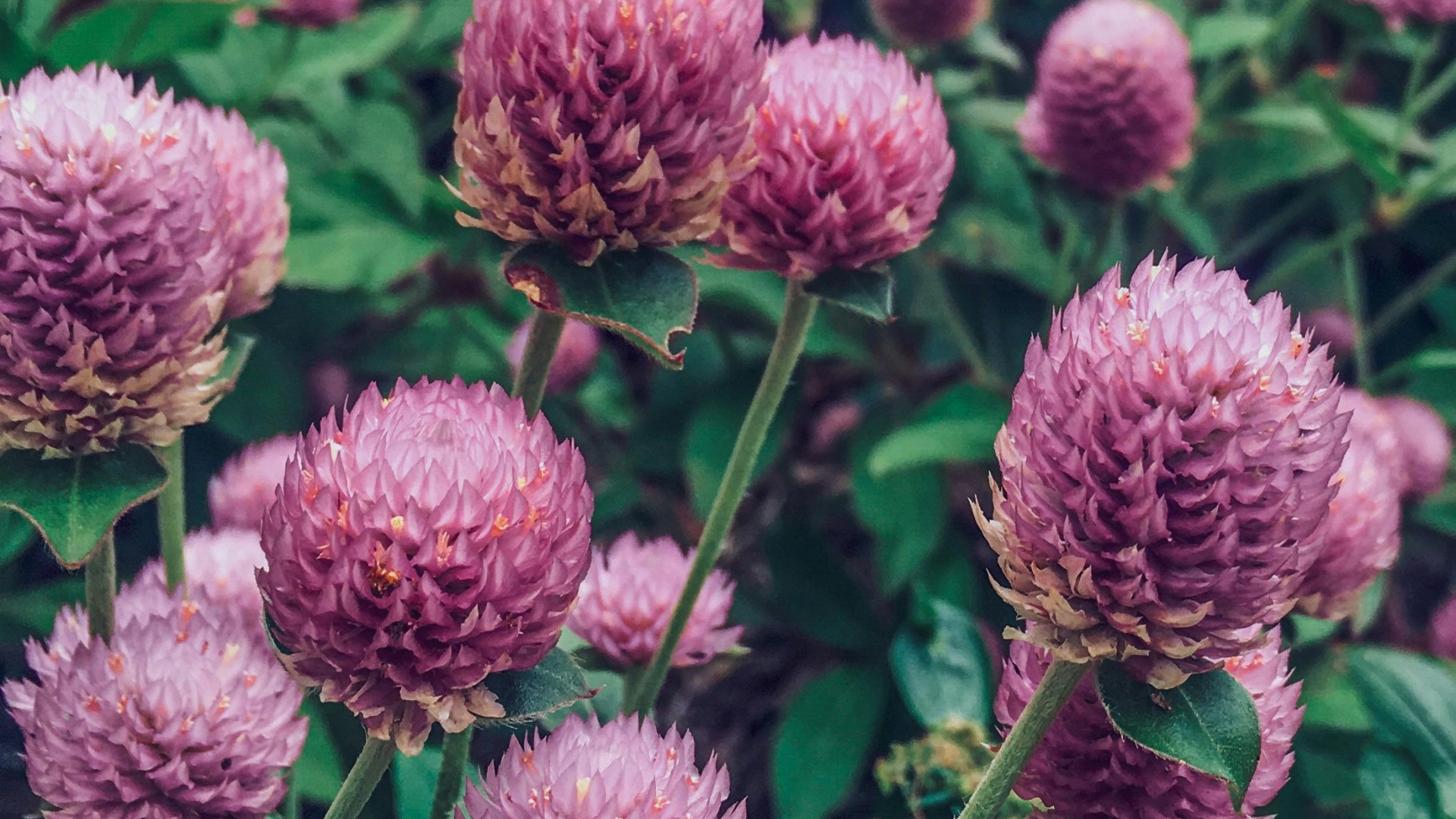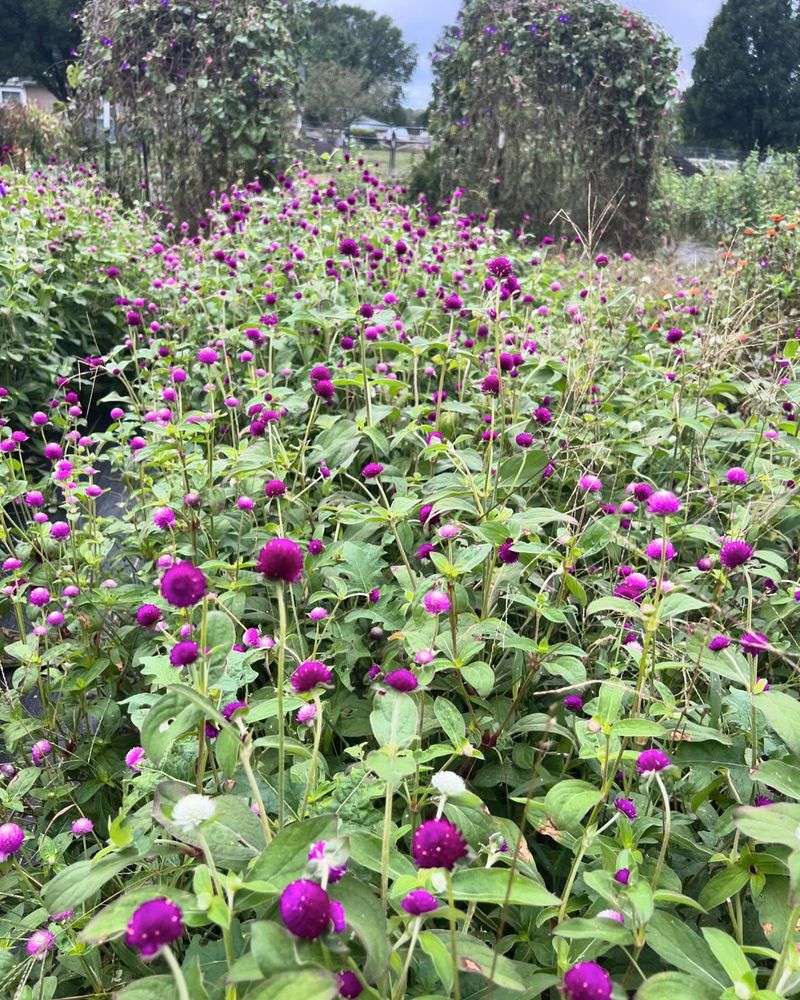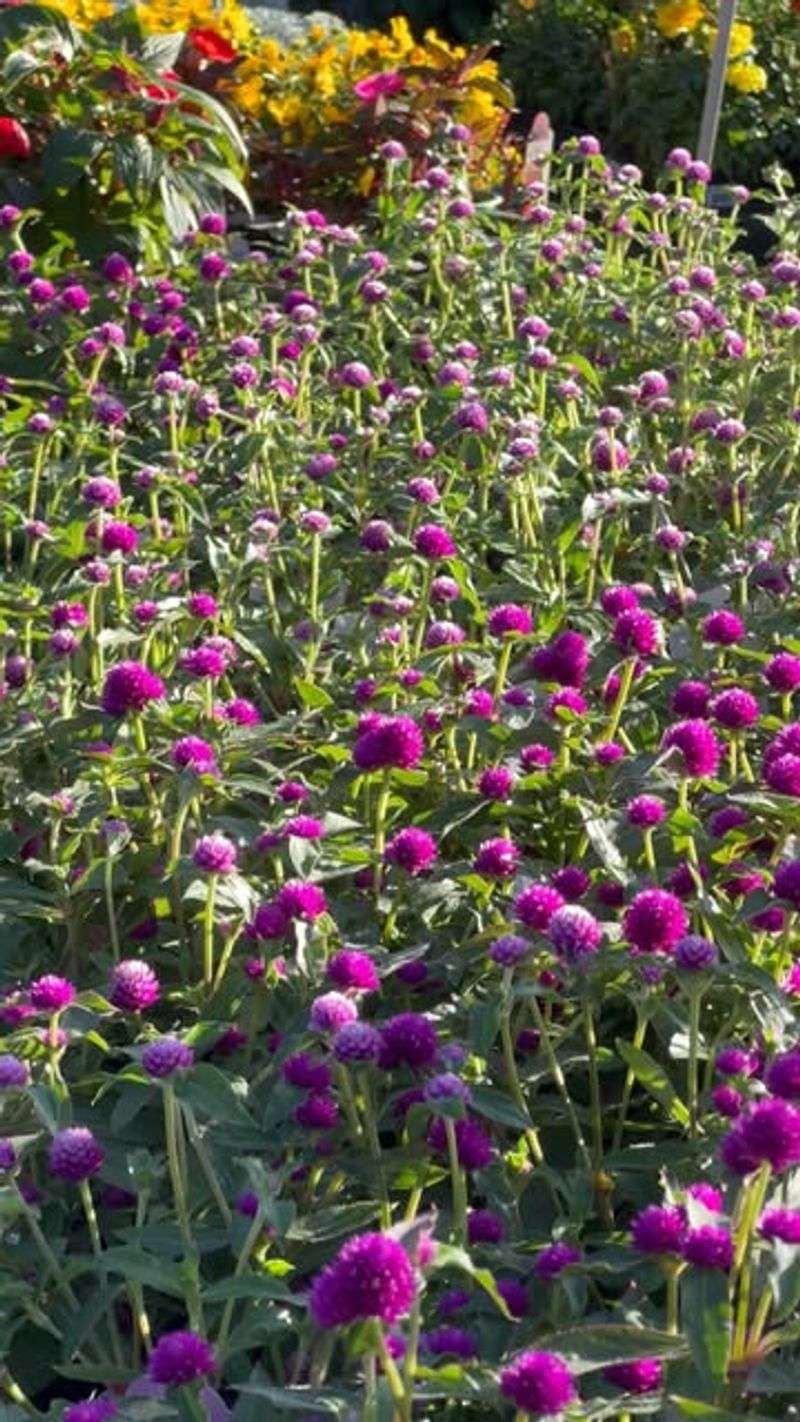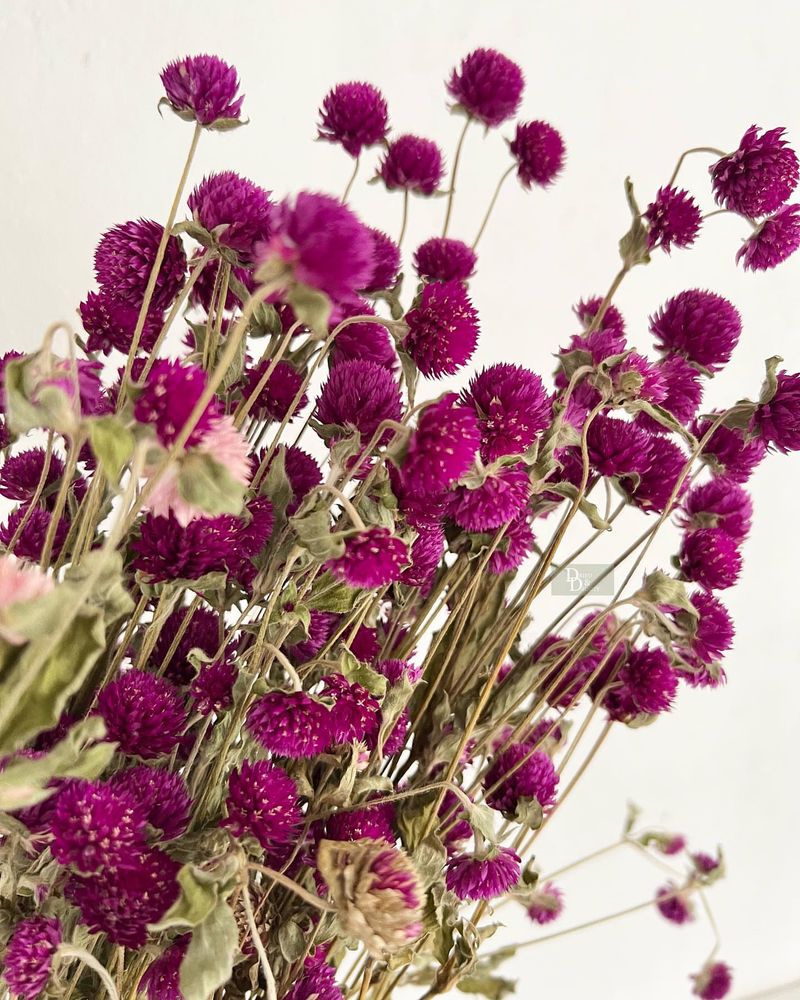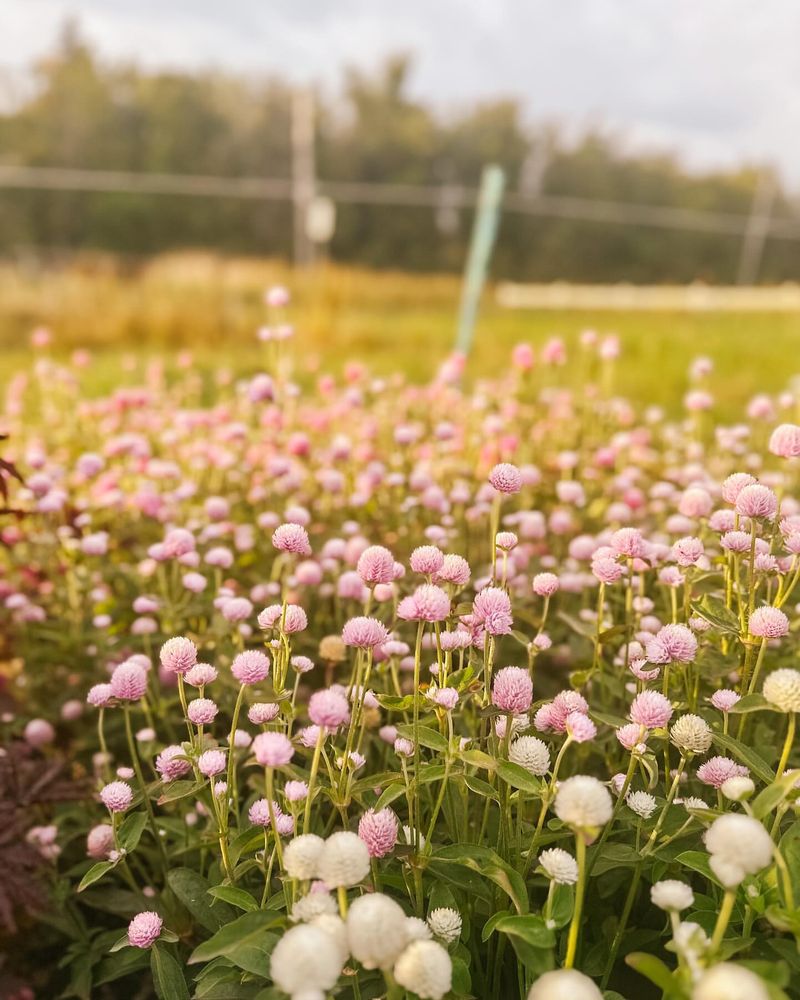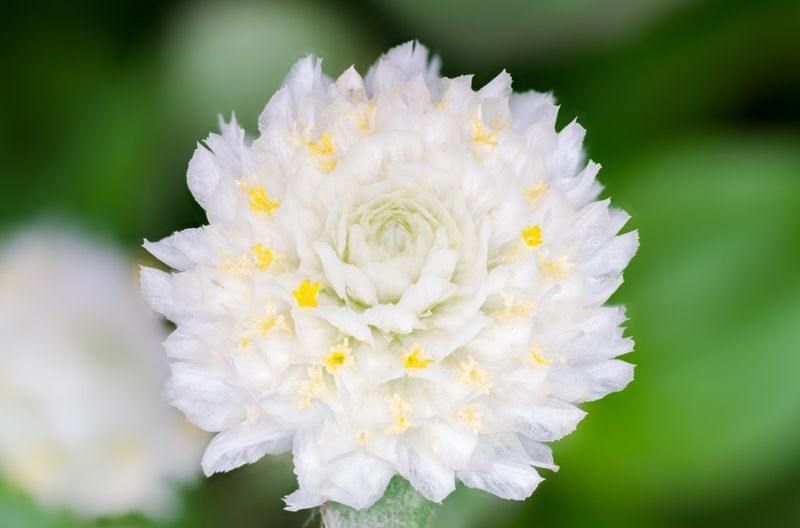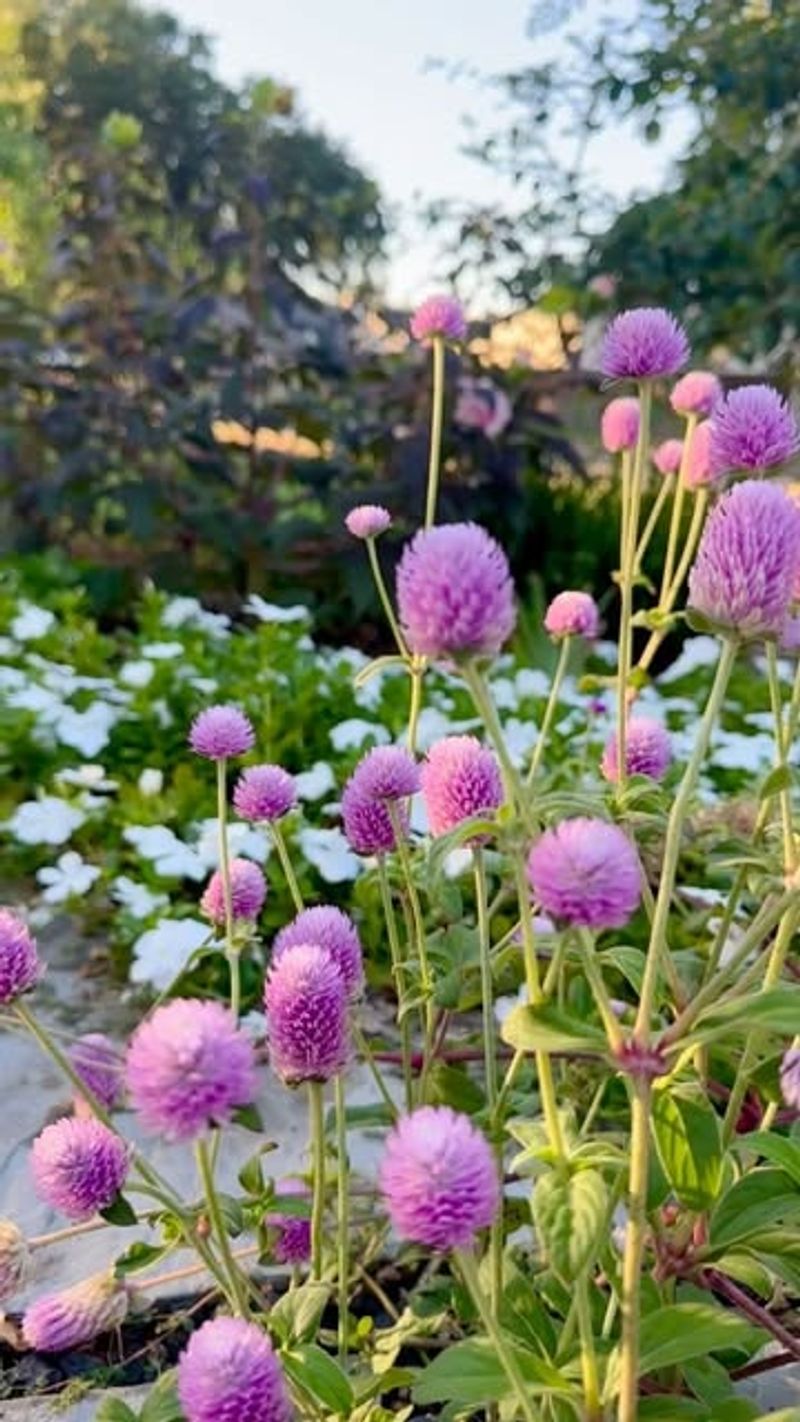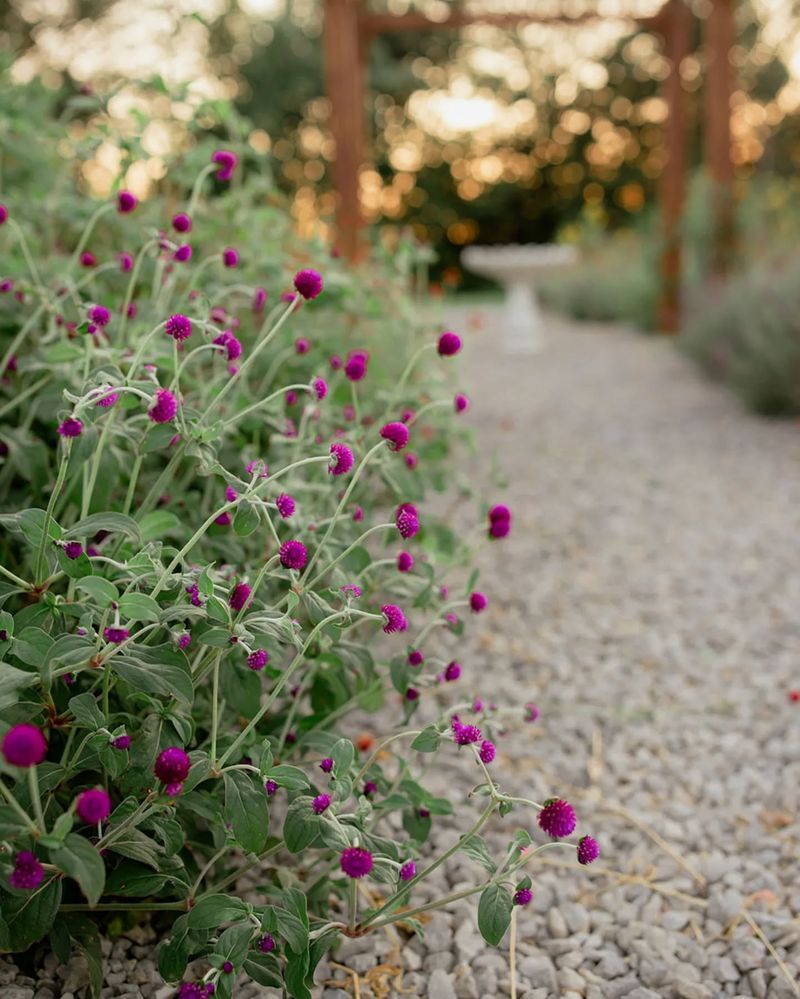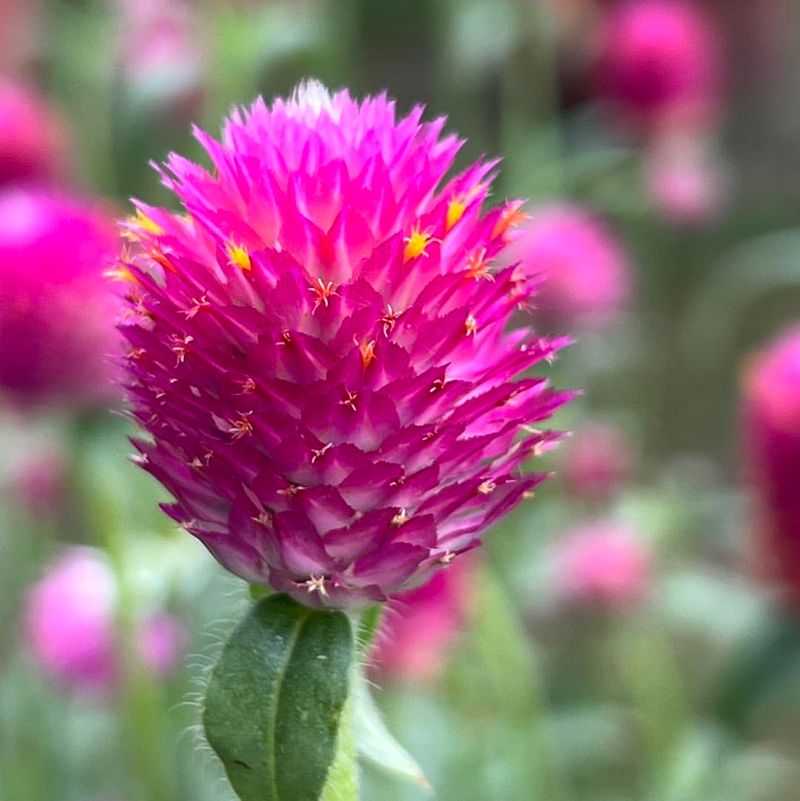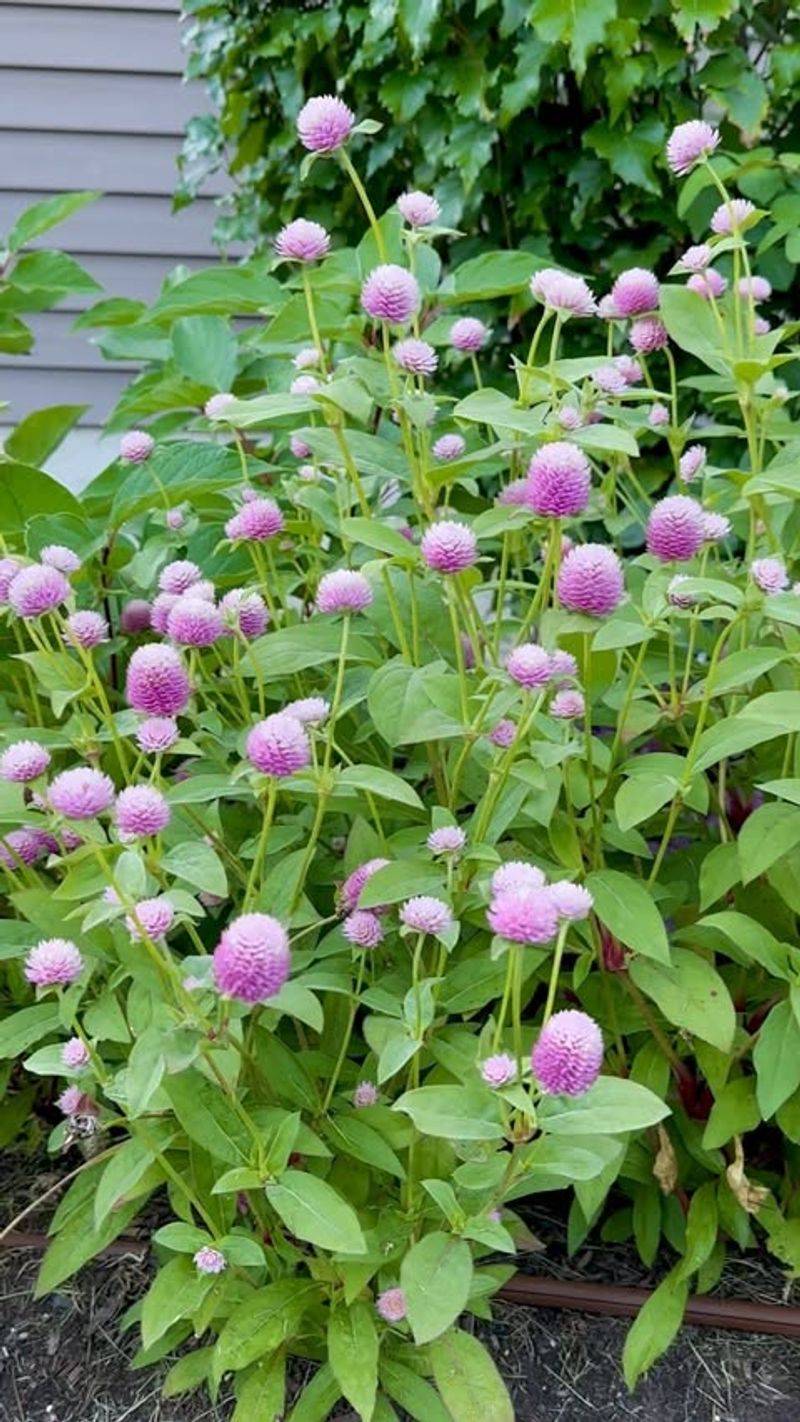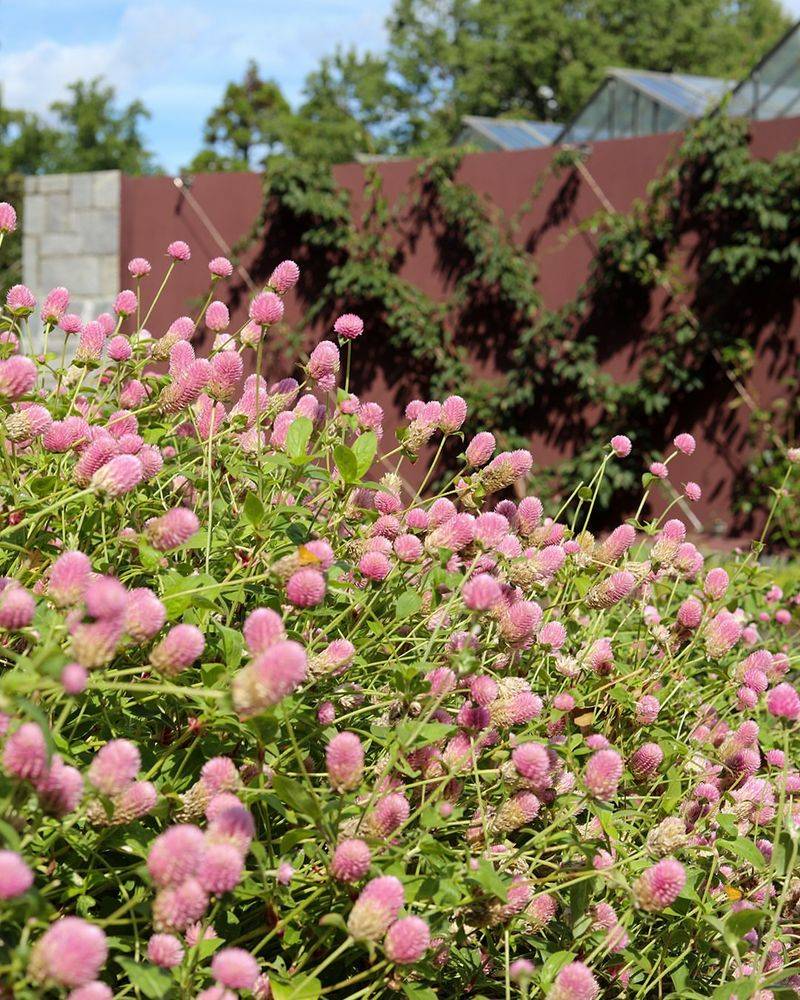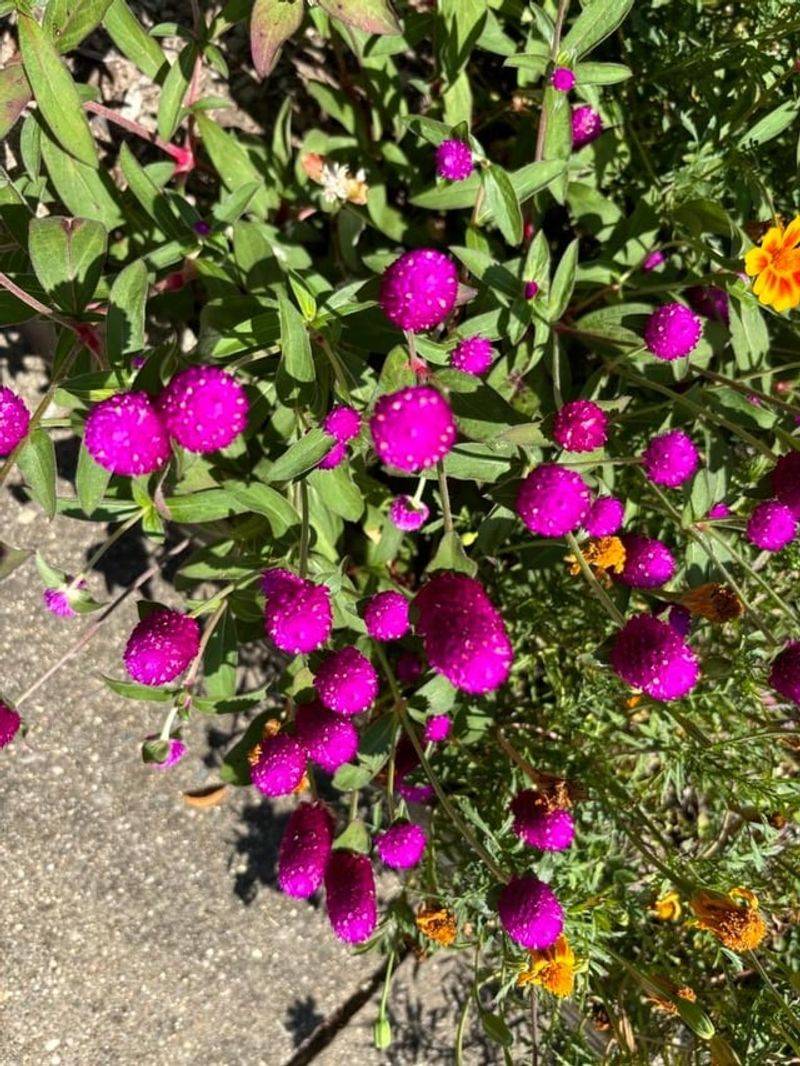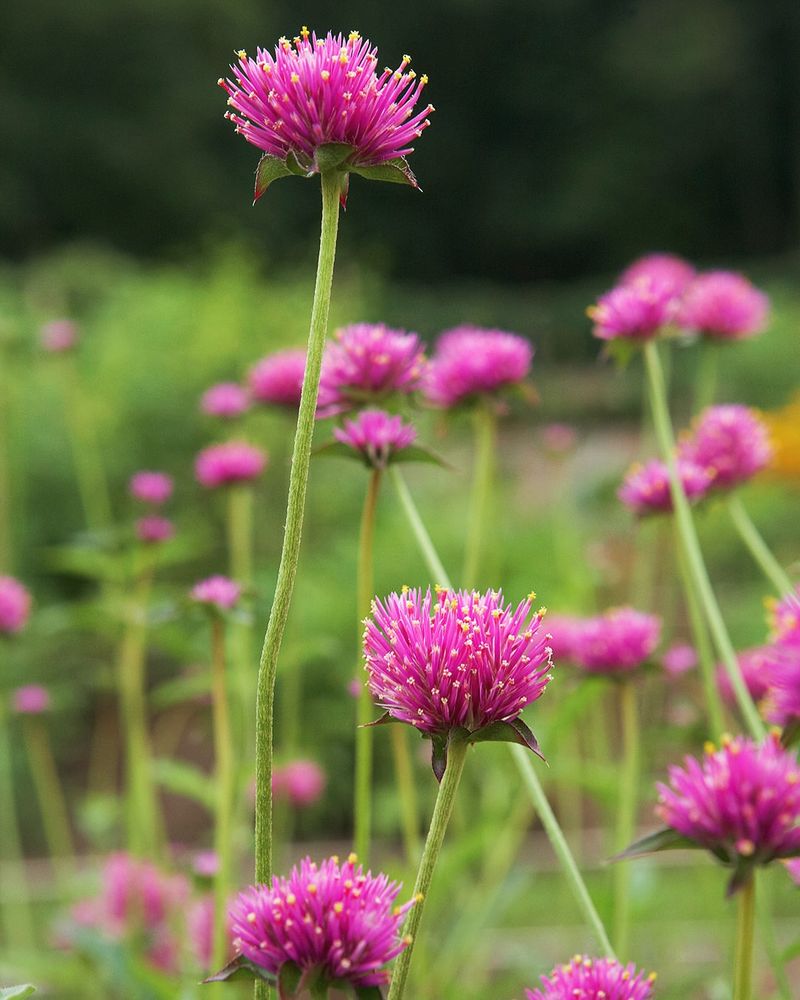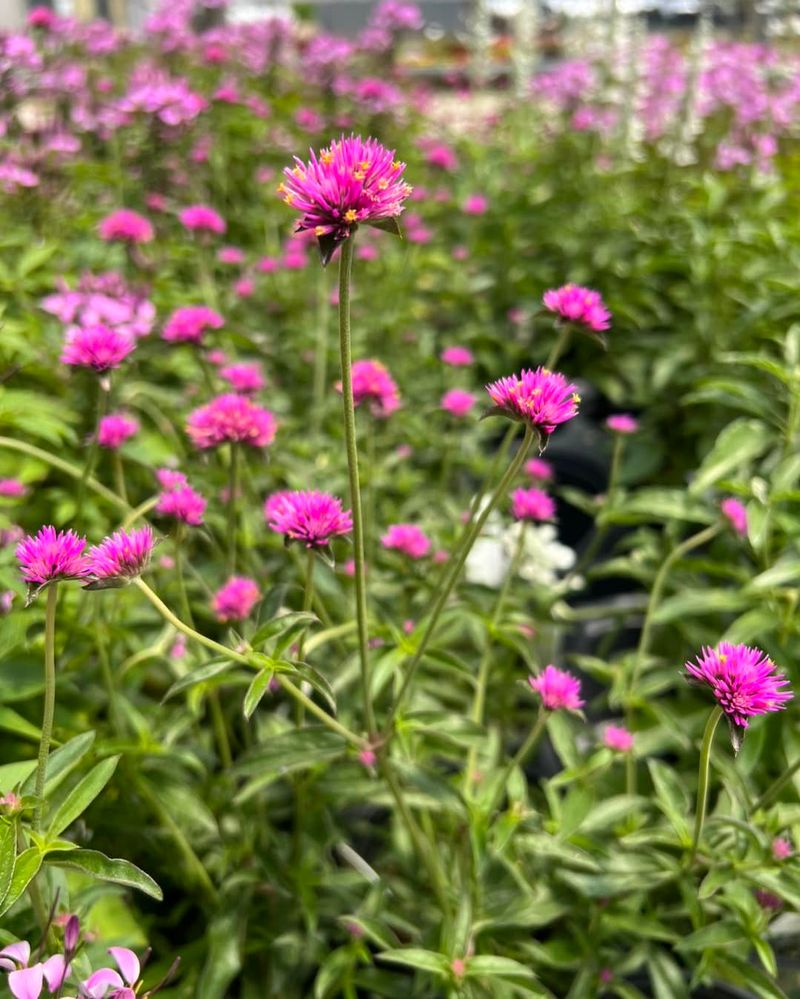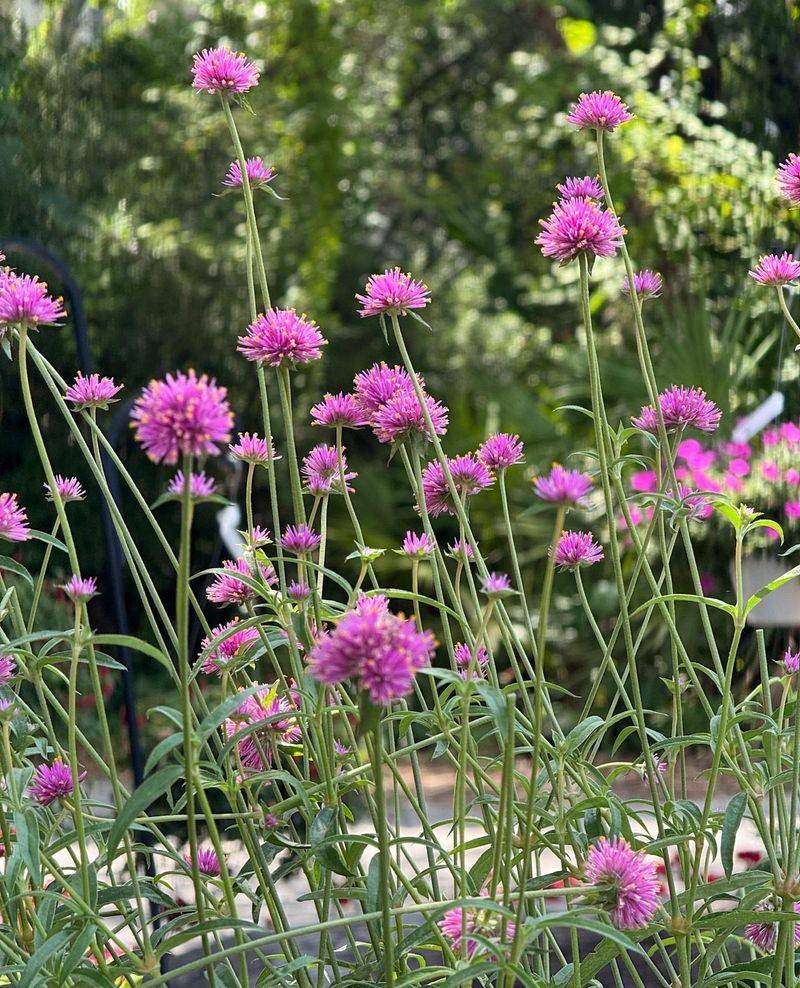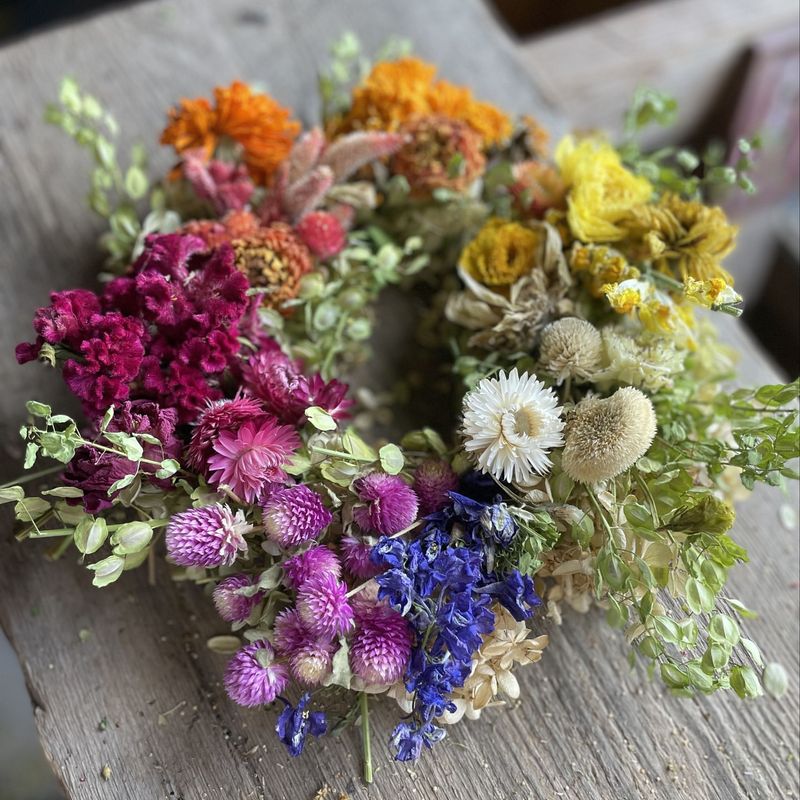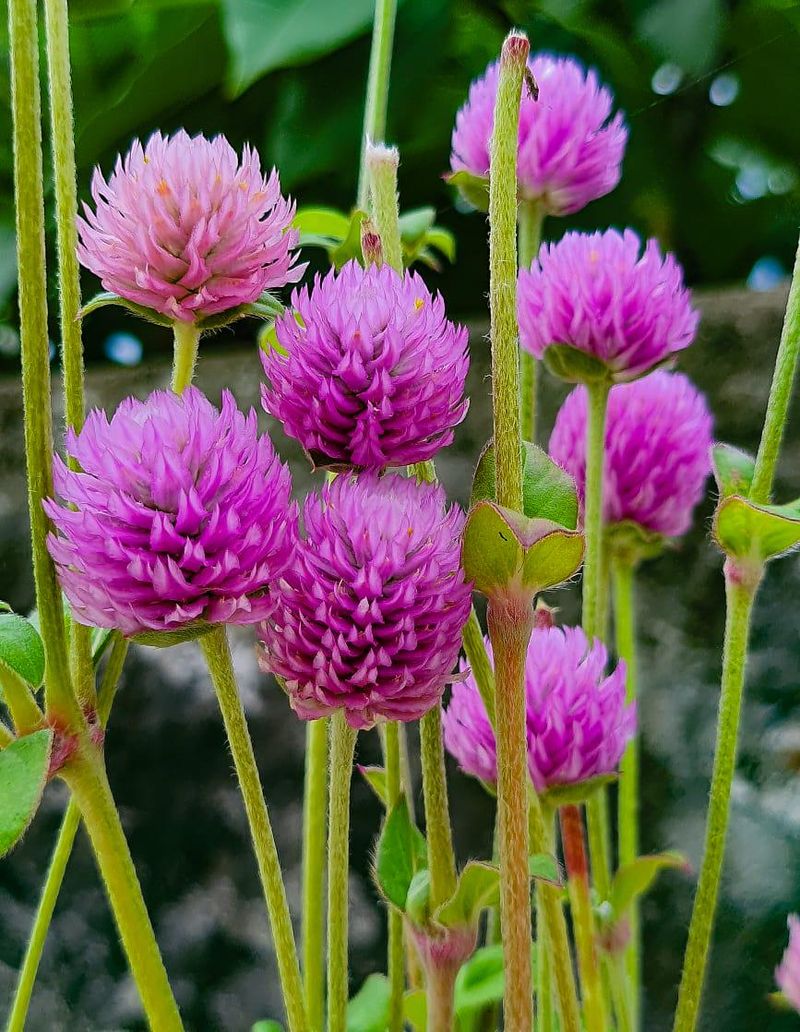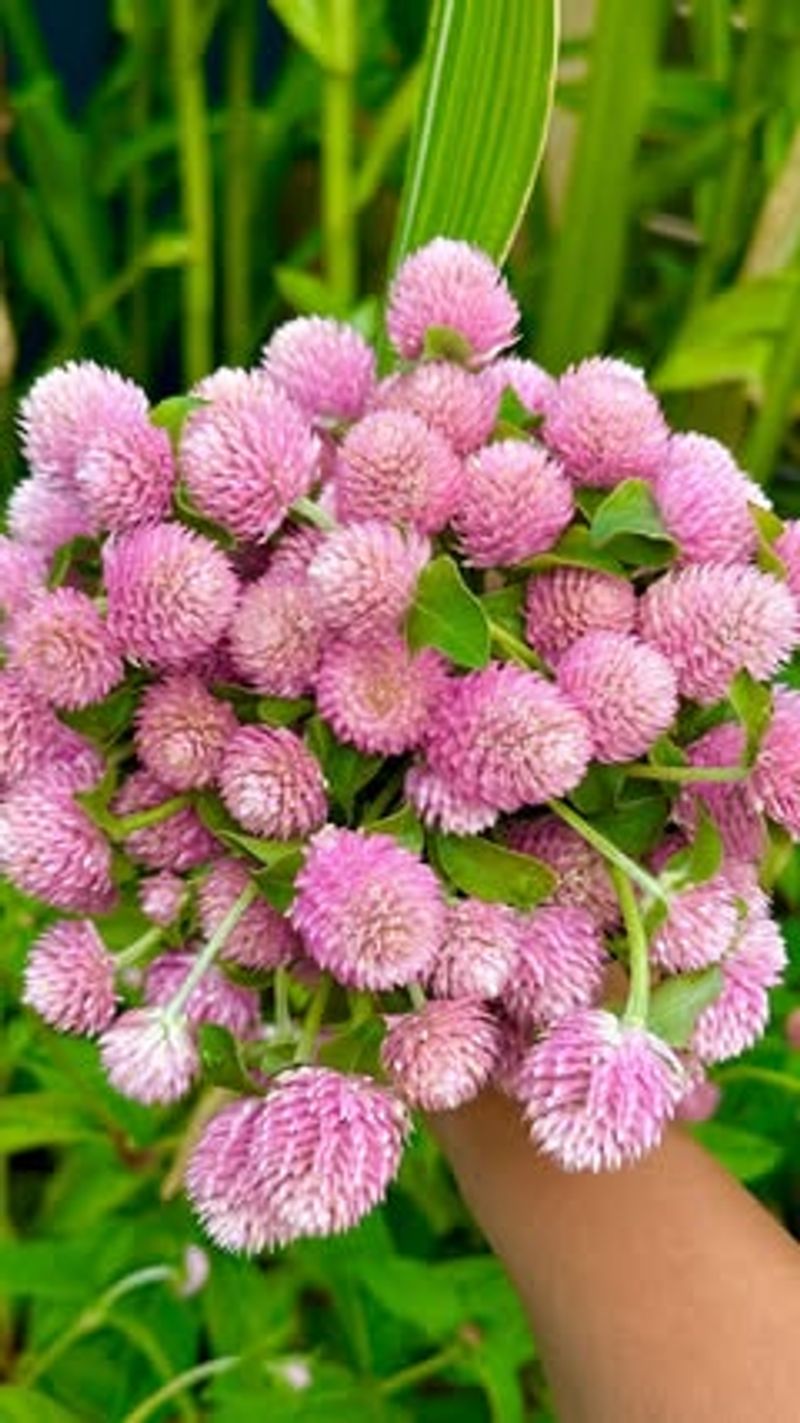Globe amaranth is a garden superstar that deserves way more attention than it gets. These cheerful, pom-pom shaped flowers bring vibrant color to gardens even during the hottest months when other plants wilt.
Gardeners who discover globe amaranth quickly add it to their must-grow list because it’s both beautiful and incredibly low-maintenance.
1. Laughs at Drought
Globe amaranth practically snickers at dry conditions that make other flowers surrender. Native to hot, arid regions, these tough little blooms have evolved special adaptations to survive with minimal water.
Once established, they can thrive for weeks without rainfall or supplemental watering. Their secret lies in their efficient root system and waxy leaves that reduce moisture loss. For gardeners in drought-prone areas, this resilience transforms flower beds from constant worry to carefree enjoyment.
2. Sun-Worshipper
Unlike delicate flowers that wilt under intense sunshine, globe amaranth flourishes in full, blazing sun. The hotter the better for these colorful blooms! Their ability to thrive in spots where other plants struggle makes them perfect for those challenging south-facing gardens.
No need for shade cloth or afternoon protection – globe amaranth actually produces more flowers and stronger stems when bathed in sunlight all day long. For gardeners with sun-drenched yards, these heat-lovers are the answer to empty garden beds.
3. Blooms Forever
Most annual flowers have a frustratingly short bloom period, but globe amaranth keeps producing flowers from early summer until frost. This marathon blooming habit gives gardeners months of color instead of just weeks.
The secret behind their stamina? Globe amaranth continuously sets new buds as older flowers mature. Regular deadheading encourages even more blooms, though these persistent performers flower abundantly even with minimal care. For gardeners seeking long-lasting color, few annuals can match globe amaranth’s impressive flowering duration.
4. Cuts Like a Dream
Flower arrangers treasure globe amaranth for its exceptional vase life. Cut stems last an astonishing 7-10 days in water, maintaining vibrant color and firm shape throughout. Their rounded form adds wonderful textural contrast to bouquets.
Beyond fresh arrangements, globe amaranth excels as a dried flower. Simply hang bunches upside down in a dark, dry place, and they’ll retain their color for months or even years. Many gardeners grow dedicated cutting patches just for these versatile blooms that transition seamlessly from garden to vase to dried arrangements.
5. Color Explosion
Garden centers typically stock just purple globe amaranth, but adventurous gardeners discover a rainbow of options when exploring seed catalogs. Vibrant pinks, deep reds, pure whites, and sunny oranges create striking combinations in flower beds.
Some varieties even feature bicolor blooms with subtle color shifts from center to edge. Mix several colors together for an eye-catching display, or mass single colors for dramatic impact. The ‘Strawberry Fields’ variety offers brilliant red, while ‘All Around Purple’ provides rich violet tones – both guaranteed to draw compliments from visitors.
6. Butterfly Magnet
Watching butterflies flutter between globe amaranth blooms brings garden magic to life. These nectar-rich flowers attract a diverse array of pollinators, turning gardens into wildlife havens. The flower’s unique structure provides perfect landing pads for butterflies to rest while feeding.
Monarchs, swallowtails, and painted ladies are particularly drawn to globe amaranth’s sweet nectar. For gardeners concerned about declining pollinator populations, adding these flowers creates valuable habitat. The bonus? More butterflies mean more enjoyment while you’re relaxing on the patio.
7. Self-Seeding Surprise
Globe amaranth performs a delightful disappearing act each fall, only to reappear the following summer in unexpected places. These enthusiastic self-seeders drop tiny seeds that sprout when conditions warm up, creating free plants without any effort on your part.
Unlike aggressive self-seeders that become weedy nuisances, globe amaranth maintains a perfect balance – enough volunteers to be useful without becoming overwhelming. Many gardeners find these surprise plants pop up in just the right spots, creating natural-looking drifts that professional designers strive to achieve.
8. Container Champion
Apartment dwellers and small-space gardeners rejoice! Globe amaranth thrives in containers, bringing drought-resistant beauty to patios, balconies, and even sunny windowsills. Their compact growth habit means they won’t overwhelm other plants in mixed planters.
Their shallow root system makes them perfect partners for deeper-rooted container plants. For maximum impact, plant them near the edges where their round blooms can cascade slightly over the rim. The best part? Their drought tolerance means forgotten waterings won’t spell disaster – a huge advantage for busy container gardeners.
9. Pest-Resistant Performer
While other garden favorites get devoured by insects, globe amaranth stands strong with remarkable pest resistance. Their slightly fuzzy stems and leaves naturally deter many common garden pests. Even deer and rabbits typically pass them by in favor of tastier treats!
This natural defense system means gardeners can skip the chemical sprays and still enjoy perfect blooms. For organic gardeners, this resistance makes globe amaranth a cornerstone plant. Their ability to stay beautiful without intervention reduces garden maintenance and increases enjoyment – a win-win for busy gardeners.
10. Budget-Friendly Beauty
Garden centers charge premium prices for drought-resistant perennials, but globe amaranth delivers similar benefits at a fraction of the cost. A single packet of seeds costs less than a fancy coffee and produces dozens of plants.
Even buying started plants remains affordable compared to other garden options. Their self-seeding habit multiplies the value – invest once and enjoy free plants for years. For budget-conscious gardeners, few flowers deliver such impressive performance at such a modest price point. Their long bloom period further stretches your garden dollar.
11. Edible Garnish
Surprise dinner guests with globe amaranth’s secret talent – edibility! These beautiful blooms double as striking garnishes for special meals. Their mild, slightly sweet flavor and unique appearance elevate ordinary dishes to restaurant quality.
Sprinkle the tiny florets over salads for color pops, or use whole blooms to decorate cakes and desserts. Always grow them without chemicals if planning to eat them. While not a primary food source, their edible nature adds another dimension to their garden value, especially for creative cooks who love to incorporate garden elements into their culinary creations.
12. Kid-Friendly Growing Project
Children’s gardening success starts with foolproof plants, and globe amaranth tops the list for young green thumbs. The seeds germinate quickly and reliably, providing fast gratification for impatient little gardeners. Their drought tolerance forgives forgotten watering duties.
Kids love the bright colors and unusual pom-pom shape that’s so different from typical flowers. The seeds are large enough for small fingers to handle easily during planting. Many teachers include globe amaranth in school garden projects because of their high success rate and educational value about plant adaptations.
13. Space-Saving Vertical Growth
Unlike sprawling garden plants that hog precious space, globe amaranth grows primarily upward. Their neat, vertical growth habit allows gardeners to pack more plants into limited space without overcrowding issues.
Most varieties reach 18-24 inches tall while staying relatively narrow at the base. This upright nature makes them perfect for garden borders, tight spaces between other plants, or anywhere garden real estate is valuable. Urban gardeners particularly appreciate how many globe amaranth plants can fit into small raised beds without sacrificing air circulation.
14. Medicine Cabinet in the Garden
Long before globe amaranth became a garden favorite, traditional healers valued it for medicinal properties. In many cultures, dried blooms steeped into tea were used to treat respiratory conditions and digestive issues.
Modern herbalists still incorporate globe amaranth into wellness preparations. Research suggests certain compounds in the plant may have anti-inflammatory properties. While not a replacement for conventional medicine, growing these flowers connects gardeners to ancient plant wisdom. Their potential health benefits add another dimension beyond mere ornamental value.
15. Holiday Crafting Material
Crafters treasure globe amaranth for holiday projects long after the growing season ends. The dried flowers maintain their shape and color remarkably well, perfect for Christmas wreaths, ornaments, and festive arrangements.
Their papery texture means they don’t shatter or crumble like many dried flowers. The vibrant colors complement traditional holiday decor – red varieties for Christmas, purple for Advent, white for elegant winter themes. Many gardeners grow extra plants specifically for crafting purposes, harvesting and drying blooms at their peak to ensure a supply of crafting materials through winter months.
16. Soil Flexibility Champion
Fussy plants demand perfect soil conditions, but globe amaranth thrives in almost any soil type. Sandy, rocky, clay, or loamy – these adaptable plants adjust to whatever ground they’re given. Their flexible nature means success in locations where other flowers fail.
The only soil condition they truly dislike is constantly wet, soggy ground. Otherwise, they’ll flourish without amendments or special preparation. This adaptability makes them perfect for new gardens with poor soil, rental properties where investing in soil improvement doesn’t make sense, or problem areas where other plants struggle.
17. Low-Allergen Option
Gardens should bring joy, not sneezing fits! Globe amaranth offers a perfect solution for allergy sufferers who still want beautiful flowers. Unlike many garden favorites that release abundant pollen, globe amaranth produces minimal airborne allergens.
Their unique flower structure keeps most pollen contained rather than floating freely. This makes them ideal for planting near patios, windows, and other areas where people gather. Gardeners with pollen sensitivities often build entire landscapes around low-allergen options like globe amaranth, creating beautiful outdoor spaces that don’t trigger symptoms.

